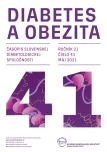Familial chylomicronemia – pathogenesis, clinical manifestations and a case report
Authors:
Katarína Rašlová 1; Alexander Klabník 2; Miroslava Hučková 3; Daniela Gašperíková 3; Anna Maňková 4; Michal Vrablík 5; Richard Češka 5; Daniela Balažiová 3
Authors‘ workplace:
Koordinačné centrum pre FHLP, SZU, Bratislava
1; Kardiologická ambulancia a MedPed centrum, Námestovo
2; Biomedicínske centrum SAV, Bratislava
3; I. interná klinika JLF UK a UNM, Martin
4; III. interní klinika – klinika endokrinologie a metabolismu 1. LF UK a VFN v Praze
5
Published in:
Diab Obez 2021; 21(41): 44-47
Category:
Case studies
Overview
Familial chylomicronemia (Familial chylomicronemia syndrome – FCS) is an autosomal recessive inherited metabolic disorder which causes mutations in the genes which have a central role in lipolysis of triglyceride-rich lipoproteíns. A characteristic manifestation of FCS is the presence of chylomicrons in plasma also after 12- hour fasting. The most common cause of this disorder are mutations in the lipoprotein lipase (LPL) gene that are found in more than 80% patients. This form of FCS is also called lipoprotein lipase deficiency (LPLD). Incidence of FCS in the population is reported to be 1–2 per 1 million. Nonetheless the progress in DNA diagnostics suggests that the incidence may be higher. A patient whose case we present has overcome recurrent acute pancreatitis 9 times. It was only her 2nd pregnancy which was free from perinatal complications and ended by birth of a healthy boy. The success is the result of intensive multidisciplinary care, consistent diet planning and education and the right decision to commence the plasmapheresis treatment in the 3rd trimester of pregnancy.
Keywords:
chylomicron – familial chylomicronemia syndrome – lipoprotein lipase deficiency – lipoprotein lipase gen – plasmapheresis
Sources
- Rašlová K. Metabolizmus lipoproteínov, dyslipoproteinémie a ateroskleróza. In: Mokáň M, Martinka E, Galajda P (eds). Diabetes mellitus a vybrané metabolické ochorenia. Vydavateľstvo P + M: Turany 2008: 768–825. ISBN 9788096971398.
- Stroes E, Moulin P, Parhofer KG et al. Diagnostic algorithm for familial chylomicronemia syndrome. Atheroscler Suppl 2017; 23: 1–7. Dostupné z DOI: <http://dx.doi.org/10.1016/j.atherosclerosissup.2016.10.002>.
- Rodrigues R, Artieda M, Tejedor D. Pathogenic classification of LPL gene variants reported to be associated with LPL deficiency. J Clin Lipidol 2016; 10(2): 394–409. Dostupné z DOI: <http://dx.doi.org/10.1016/j.jacl.2015.12.015>.
- Brown WV, Gaudet D, Goldberg I et al. Roundtable on etiology of familial chylomicronemia syndrome. J Clin Lipidol 2018; 12(1): 5–11. Dostupné z DOI: <http://dx.doi.org/10.1016/j.jacl.2017.12.015>.
- Lloret-Linares C, Pelletier AL, Czernichow S et al. Acute pancreatitis in a cohort of 129 patients referred for severe hypertriglyceridemia. Pancreas 2008; 37(1): 13–22. Dostupné z DOI: <http://dx.doi.org/10.1097/MPA.0b013e31816074a1>.
- Wong B, Ooi TC, Keely E. Severe gestational hypertriglyceridemia: A practical approach for clinicians. Obstet Med 2015; 8(4): 158–167. Dostupné z DOI: <http://dx.doi.org/10.1177/1753495X15594082>.
- Steinhagen-Thiessen E , Stroes E, Soran H , Johnson C et al. [GENIALL Investigators]. The role of registries in rare genetic lipid disorders: Review and introduction of the first global registry in lipoprotein lipase deficiency. Atherosclerosis 2017; 262: 146–153. Dostupné z DOI: <http://dx.doi.org/10.1016/j.atherosclerosis.2016.08.023>.
- Brahm AJ, Hegele RA. Chylomicronaemia: current diagnosis and future therapies. Nat Rev Endocrinol 2015;11(6): 352–362. Dostupné z DOI: <http://dx.doi.org/10.1038/nrendo.2015.26>.
- Goldberg AS, Hegele RA. Severe hypertriglyceridemia in pregnancy. J Clin Endocrinol Metab 2012; 97(8): 2589–2596. Dostupné z DOI: <http://dx.doi.org/10.1210/jc.2012–1250>.
- Lim R, Rodger SJ, Hawkins TL. Presentation and management of acute hypertriglyceridemic pancreatitis in pregnancy: A case report. Obstet Med 2015; 8(4):200–203. Dostupné z DOI: <http://dx.doi.org/10.1177/1753495X15605697>.
Labels
Diabetology ObesitologyArticle was published in
Diabetes and obesity

2021 Issue 41
Most read in this issue
- Discordance between blood glucose and HbA1c – is an explanation possible according to the biokinetic model of glycation?
- The potential of induced pluripotent stem cells in the study and treatment of monogenic diabetes
- Today we can influence overweight and obesity – and thus prevent their consequences, as is the development of diabetes or cardiovascular disease
- News in the field of 2nd generation of basal insulin analogs in type 1 diabetes and data from continuous glucose monitoring
